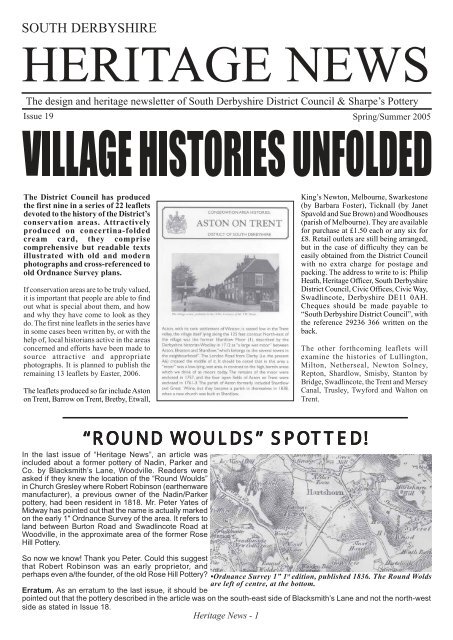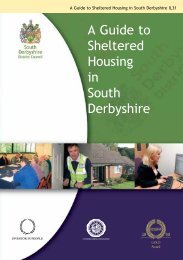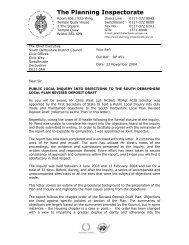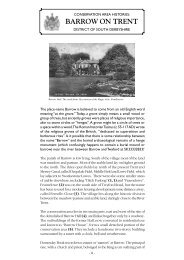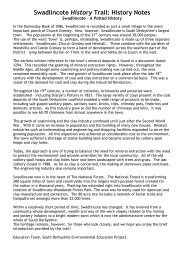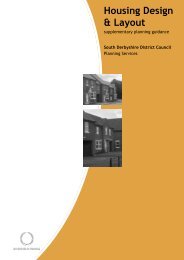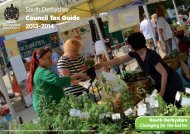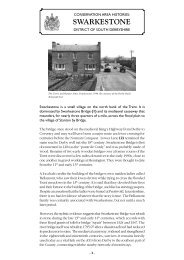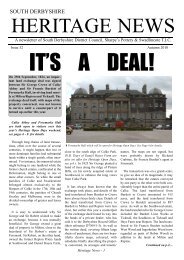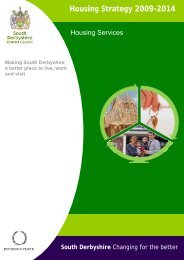Heritage News 19 - South Derbyshire District Council
Heritage News 19 - South Derbyshire District Council
Heritage News 19 - South Derbyshire District Council
You also want an ePaper? Increase the reach of your titles
YUMPU automatically turns print PDFs into web optimized ePapers that Google loves.
SOUTH DERBYSHIRE<br />
HERITAGE NEWS<br />
The design and heritage newsletter of <strong>South</strong> <strong>Derbyshire</strong> <strong>District</strong> <strong>Council</strong> & Sharpe’s Pottery<br />
Issue <strong>19</strong><br />
Spring/Summer 2005<br />
The <strong>District</strong> <strong>Council</strong> has produced<br />
the first nine in a series of 22 leaflets<br />
devoted to the history of the <strong>District</strong>’s<br />
conservation areas. Attractively<br />
produced on concertina-folded<br />
cream card, they comprise<br />
comprehensive but readable texts<br />
illustrated with old and modern<br />
photographs and cross-referenced to<br />
old Ordnance Survey plans.<br />
If conservation areas are to be truly valued,<br />
it is important that people are able to find<br />
out what is special about them, and how<br />
and why they have come to look as they<br />
do. The first nine leaflets in the series have<br />
in some cases been written by, or with the<br />
help of, local historians active in the areas<br />
concerned and efforts have been made to<br />
source attractive and appropriate<br />
photographs. It is planned to publish the<br />
remaining 13 leaflets by Easter, 2006.<br />
The leaflets produced so far include Aston<br />
on Trent, Barrow on Trent, Bretby, Etwall,<br />
King’s Newton, Melbourne, Swarkestone<br />
(by Barbara Foster), Ticknall (by Janet<br />
Spavold and Sue Brown) and Woodhouses<br />
(parish of Melbourne). They are available<br />
for purchase at £1.50 each or any six for<br />
£8. Retail outlets are still being arranged,<br />
but in the case of difficulty they can be<br />
easily obtained from the <strong>District</strong> <strong>Council</strong><br />
with no extra charge for postage and<br />
packing. The address to write to is: Philip<br />
Heath, <strong>Heritage</strong> Officer, <strong>South</strong> <strong>Derbyshire</strong><br />
<strong>District</strong> <strong>Council</strong>, Civic Offices, Civic Way,<br />
Swadlincote, <strong>Derbyshire</strong> DE11 0AH.<br />
Cheques should be made payable to<br />
“<strong>South</strong> <strong>Derbyshire</strong> <strong>District</strong> <strong>Council</strong>”, with<br />
the reference 29236 366 written on the<br />
back.<br />
The other forthcoming leaflets will<br />
examine the histories of Lullington,<br />
Milton, Netherseal, Newton Solney,<br />
Repton, Shardlow, Smisby, Stanton by<br />
Bridge, Swadlincote, the Trent and Mersey<br />
Canal, Trusley, Twyford and Walton on<br />
Trent.<br />
“ROUND<br />
WOULDS”<br />
SPOTTED!<br />
In the last issue of “<strong>Heritage</strong> <strong>News</strong>”, an article was<br />
included about a former pottery of Nadin, Parker and<br />
Co. by Blacksmith’s Lane, Woodville. Readers were<br />
asked if they knew the location of the “Round Woulds”<br />
in Church Gresley where Robert Robinson (earthenware<br />
manufacturer), a previous owner of the Nadin/Parker<br />
pottery, had been resident in 1818. Mr. Peter Yates of<br />
Midway has pointed out that the name is actually marked<br />
on the early 1" Ordnance Survey of the area. It refers to<br />
land between Burton Road and Swadlincote Road at<br />
Woodville, in the approximate area of the former Rose<br />
Hill Pottery.<br />
So now we know! Thank you Peter. Could this suggest<br />
that Robert Robinson was an early proprietor, and<br />
perhaps even a/the founder, of the old Rose Hill Pottery?<br />
•Ordnance Survey 1” 1 st edition, published 1836. The Round Wolds<br />
are left of centre, at the bottom.<br />
Erratum. As an erratum to the last issue, it should be<br />
pointed out that the pottery described in the article was on the south-east side of Blacksmith’s Lane and not the north-west<br />
side as stated in Issue 18.<br />
<strong>Heritage</strong> <strong>News</strong> - 1
COME AND SEE!<br />
Two very special items from the famous Bretby Art Pottery are now<br />
on show at Sharpe’s.<br />
Melbourne is to push the boat out this coming September by staging<br />
the first “Melbourne Festival”, which it is hoped will become an<br />
annual event.<br />
The first is a unique painted canvas designed as a mural for the<br />
decorative ceiling of the pottery showroom building. It is reputed to<br />
show chief artist William Oram Trivett working at an easel, flanked<br />
by two seated ladies who are decorating pottery. The mural has<br />
had a lucky escape, having been stolen from the showroom and<br />
damaged prior to its fortunate retrieval. It has since been expertly<br />
restored, with the financial backing of the showroom owner, and<br />
will remain at Sharpe’s pending the hoped-for repair and restoration<br />
of the showroom building.<br />
Planned for the weekend of 17 th and 18 th September, local<br />
householders will be opening their homes and gardens to provide<br />
interesting and unusual settings for the work of both local and<br />
visiting artists. In addition, special events are being planned by the<br />
Melbourne Photographic Society and the St. Michaels Youth<br />
Players, and a gala evening is under consideration, involving the<br />
Town Band, the Melbourne Male Voice Choir and the Melbourne<br />
Operatic Society.<br />
Kick-start donations for funding the Festival have been made by<br />
the Melbourne Business Association and the Friends of Melbourne<br />
Parish Church. In addition, a grant is being prepared for submission<br />
to the National Lottery’s “Awards For All” for display materials<br />
etc. The weekend itself will generate income from ticketed events,<br />
sales of the festival guide (a numbered map indicating the location<br />
of host venues), and financial contributions from visiting artists.<br />
Festival Co-ordinator Phil Dobby says “We now have a proper<br />
organisation and a bank account, with money in it! One important<br />
decision made by the Festival Committee is that two or three<br />
bursaries for local young people in the field of arts or architecture<br />
will be made from surplus funds. Anything left over after that will<br />
go towards 2006!”<br />
This is an event which brings heritage and culture together and<br />
thereby embraces the past and the present at the same time. It has<br />
taken its cue partly from the well-established Wirksworth Festival,<br />
and to a smaller degree from the <strong>Heritage</strong> Open Days events that<br />
have taken place each September in Melbourne over the last five<br />
years. As in past years, some of the participating properties will be<br />
of historic interest, worthy of a visit in their own right.<br />
If you would like further information, either as a spectator or as a<br />
would-be participant, please contact the Festival Co-ordinator Phil<br />
Dobby on 01332 863640 or by<br />
e-mail: info@melbournefestival.co.uk<br />
•A Sharpe’s volunteer admires the Bretby mural<br />
The other item, scarcely less unusual than the first, is an example<br />
of the Bretby “Gypsy Boy” or “Italian Boy”. He is a seated figure<br />
wearing a hat, designed to sit on a pedestal, with his legs loosely<br />
crossed. He plays a tin whistle or similar instrument, and has a<br />
satchel slung over his shoulder. At 2’ 6" tall without his pedestal, he<br />
is now the focal point of the Bretby showcase in the first floor gallery<br />
of Sharpe’s. To complement him, Bretby Art Pottery also produced<br />
a companion female figure.<br />
NB. A feasibility study into the future of the attractive Grade II<br />
listed showroom at the Bretby Art Pottery site is currently being<br />
conducted by the <strong>Derbyshire</strong> Historic Buildings Trust, with a<br />
view to its repair and restoration when the adjoining site of<br />
the demolished pottery works is being redeveloped.<br />
•Church Street, Melbourne<br />
•The Bretby companion figures of a girl and boy.<br />
<strong>Heritage</strong> <strong>News</strong> - 2
TICKNALL POTS AND POTTERS<br />
A new book from Landmark Publishing, “Ticknall Pots and Potters”<br />
by Janet Spavold and Sue Brown, has been eagerly anticipated by<br />
local historians for some time. The book is the result of many years’<br />
work on their part and is hailed as a definitive work on the subject.<br />
Priced at £24.99, the book is available from either Sue (01530-412888)<br />
or Janet (01530-415117) if readers do not come across it elsewhere.<br />
David Barker (Stoke-on-Trent Archaeological Service) recommends<br />
it as “essential reading for anyone with an interest in pottery or<br />
pottery production”.<br />
Co-author Janet Spavold writes:<br />
“The book discusses the potting families as well as the pottery they<br />
produced. Several significant potting families have been identified; there<br />
was intermarriage among them, and the pottery trade was not confined<br />
to men only. Girls were brought up to the trade, and then worked with<br />
their husbands in family groups; some widows continued the businesses.<br />
“Much of Ticknall’s output was utilitarian ware for the kitchen<br />
and dairy, easily broken and discarded, which helps to explain<br />
why so little survives today. However, we can demonstrate the<br />
widespread distribution of Ticknall pots through documentary sources,<br />
and we discuss how and where it was sold. It has been possible to indicate<br />
likely values for the utilitarian wares over time, and to tabulate named<br />
types of pots by date. There was an extensive and sophisticated<br />
distribution network which was later adapted to serve the potteries at<br />
Stoke-on-Trent, Derby and <strong>South</strong> <strong>Derbyshire</strong>. Sales of pottery through<br />
markets and fairs can be shown to have been a significant method of<br />
distribution.”<br />
The book charts both the rise and fall of this forgotten industry, and as<br />
well as archaeologists it will be of interest to local, family and economic<br />
historians as well as archaeologists. The book sheds some new<br />
light on the problem of the Melbourne pottery as part of the discussion<br />
of the extent of the Ticknall industry.<br />
“Ticknall pots were sold throughout central England for over 400 years.<br />
Already well-known to archaeologists, this study will enable “Ticknall<br />
Ware” to be interpreted more accurately when it is encountered on<br />
archaeological sites. In its early period, we suggest, pottery from Ticknall<br />
was probably better known than that from the Stoke-on-Trent area. The<br />
pottery was sold from Lincolnshire to Cheshire and from Lancashire to<br />
Shropshire.<br />
“All the Ticknall pottery mentioned in Leicestershire probate inventories<br />
has been mapped, to show the rise and fall of the industry. The output of<br />
other potteries such as those at Boston, Burslem and Wednesbury is<br />
discussed for comparison, along with imported pottery. Decorated<br />
Cistercian wares have been found through extensive fieldwalking. Some<br />
of these fragments are exceptional for their date, featuring small but<br />
exquisitely-modelled animals or flowers.<br />
•“small but exquisitely modelled”. Ticknall ware fragments<br />
showing dogs, with 5p piece for scale.<br />
FEELING GARRULOUS?<br />
Come along and celebrate ‘Memories of Swad and Melbourne’ !<br />
May is the Historical<br />
Association’s “Local History<br />
Month”. To mark the event,<br />
the National Forest’s<br />
“LANDshapes” Project has<br />
joined forces with the<br />
<strong>Derbyshire</strong> County Library<br />
Service and local heritage<br />
groups to organise two<br />
unique events.<br />
Everyone is invited, free of<br />
charge, to come along to<br />
“Memories of Swad” on May<br />
17 th, 10am – 6pm, at<br />
Swadlincote Library and<br />
“Memories of Melbourne” on<br />
May 23 rd , 2pm – 6pm at<br />
Melbourne Library.<br />
Both events involve seeing,<br />
sharing and saving our local<br />
history. See how lives and<br />
landscapes have changed in the<br />
area and listen to a collection of<br />
recorded conversations with<br />
local people, telling their life<br />
stories.<br />
The Swadlincote event will<br />
feature a fascinating display of<br />
•An old photograph of the Delph or Market Place, Swadlincote.<br />
By courtesy of the Derby Evening Telegraph.<br />
photographs and artefacts by the<br />
Friends of Eureka Park and the<br />
<strong>South</strong> <strong>Derbyshire</strong> Mining<br />
photographs of Melbourne, taken<br />
over the last 15 years, and<br />
Melbourne Civic Society will<br />
display images from their own<br />
archives.<br />
Preservation Group.In<br />
Melbourne, the Melbourne<br />
Historical Research Group will<br />
present a local history display What you remember and can<br />
and their new book ‘Melbourne share is important! Both events<br />
1820-1875; A Diary by John are chances to share your<br />
Joseph Briggs’ will be on sale. memories of how the<br />
Local photographer Peter Clough Swadlincote and Melbourne<br />
will be exhibiting his areas have changed in your<br />
<strong>Heritage</strong> <strong>News</strong> - 3<br />
lifetime. Please bring in your<br />
own old photographs or<br />
objects that relate to bygone<br />
industries and ways of living.<br />
Have a look in your attics,<br />
sheds and wardrobes for<br />
memorabilia of days gone by<br />
to bring along.<br />
Saving your knowledge,<br />
memories and stories for<br />
future generations is an<br />
important part of both events.<br />
The organisers invite you to<br />
take part in the LANDshapes<br />
scheme, which is creating a<br />
collection of local history<br />
information, contributed by<br />
local people. Help will be on<br />
hand to record and add your<br />
memories to the new<br />
LANDshapes community<br />
archive.<br />
For further information, contact<br />
Lucy Ashworth at LANDshapes<br />
01283 551211 or Kathryn Durkan<br />
at Swadlincote Library 01283<br />
217701<br />
Lucy Ashworth
UNUSUAL HISTORIC DIARY<br />
PUBLISHED<br />
Victorian life in a <strong>South</strong> <strong>Derbyshire</strong> village seen through the eyes<br />
of a gentleman farmer, poet, natural and local historian is revealed<br />
in a new book published by the Melbourne Historical Research<br />
Group, in conjunction with <strong>Derbyshire</strong> County <strong>Council</strong> and <strong>South</strong><br />
<strong>Derbyshire</strong> <strong>District</strong> <strong>Council</strong>. Priced at £10.99, the book is good<br />
value with more than 240 pages including a sixteen-page colour<br />
section.<br />
John Joseph Briggs from King’s Newton in the parish of Melbourne<br />
kept a diary from 1845 to 1875 covering all aspects of life from<br />
national events to ‘everyday tales of village folk’. A few<br />
retrospective entries record events back to 1820. Now his<br />
thoughtful and unusual memoir spanning 55 years has been<br />
transcribed from the original manuscript into a glossy paperback,<br />
which was launched at Melbourne on Friday 22 April.<br />
Nominally a farmer, Briggs himself confessed that “To employment<br />
of an agricultural nature I had from infancy a great aversion”.<br />
Moreover, Briggs never enjoyed good health and was the only<br />
one of his parents eight children to achieve the age of 25. So after<br />
his father ceased to be active on the farm, he managed the office<br />
side of the business and left the heavy work to employees. The<br />
farm was a prosperous one on the Melbourne Estate, and was<br />
profitable enough to support Briggs while he did much as he liked.<br />
He wrote extensive notes on natural and local history, composed<br />
poetry and published three histories of Melbourne in 1839, 1852<br />
and 1870.<br />
As an amateur historian, it’s not surprising that Briggs wrote his<br />
diary with posterity in mind. He probably never dreamt that it would<br />
ever be published, but he certainly wanted future generations to<br />
read it.<br />
“Many of the notes I am fully aware may seem uninteresting and<br />
unworthy of record and yet I cannot but imagine that even the<br />
most trivial in distant years must be found useful - for oftentimes a<br />
small well authenticated fact tends most materially to forward a<br />
great end. Improvements are in progress and we like to see the<br />
state of objects before such were effected. Times & manners change<br />
and man loves to contemplate how men lived & acted before him.<br />
We live in a changing age and I conceive that half a century hence<br />
we shall view the present time with as much amusement as we<br />
now look back upon that which is past.”<br />
The content of the diary is wide-ranging. Briggs describes events<br />
of national significance like the<br />
Crimean War down to the latest<br />
fashions of home life, such as the<br />
introduction of Christmas trees or<br />
the new trend for growing a<br />
beard. One of the diary entries<br />
describes how plans for a new<br />
railway line linking Rugby and<br />
Manchester were opposed at<br />
Swarkestone by Sir John Harpur<br />
Crewe of Calke who hired fifty<br />
people to prevent surveyors<br />
entering his land. Briggs<br />
•J.J. Briggs as a young man.<br />
By courtesy of Mr G.R. Heath.<br />
describes how “The company<br />
procured about eighty others<br />
from Melbourne and<br />
<strong>Heritage</strong> <strong>News</strong> - 4<br />
elsewhere…when Sir John’s men saw the opposite party were not<br />
to be lightly frustrated they quietly and very prudently withdrew.”<br />
The diary also reveals that the Victorians experienced some of the<br />
same problems that we encounter today such as erratic, unseasonal<br />
weather and “cattle plague”, which swept the country in 1866.<br />
“Melbourne 1820 – 1875: A Diary by John Joseph Briggs”, edited<br />
by Philip Heath, is available from local bookshops. It is also<br />
available to order at £13.00 (to cover postage and packing), from<br />
<strong>Derbyshire</strong> Libraries Service, County Hall, Matlock, DE4 3AG.<br />
Cheques should be made payable to <strong>Derbyshire</strong> County <strong>Council</strong>.<br />
LISTENING AND LEARNING<br />
Roger Kitchen, who has recently been working for the National Forest’s<br />
LANDshapes project, tells us what he’s been up to:<br />
For the last 3 months I’ve had a dream job. I’ve been recording the<br />
memories of 36 people who live within the National Forest area, as<br />
part of the National Forest Company’s “LANDshapes <strong>Heritage</strong> in the<br />
Making” Project.<br />
The idea behind LANDshapes is to work with local people to capture,<br />
record and celebrate the landscape and cultural heritage of The National<br />
Forest by creating an on-line archive that can hold a variety of types of<br />
historical information - written documents, photographs, maps and oral<br />
histories. (Visit the website at www.landshapes.org)<br />
The site already included historic maps, documents and photos, but<br />
was lacking that very important historical source - the evidence of local<br />
eyewitnesses. My work has done a little to rectify that and the first<br />
extracts from my interviews are now starting to appear on the website<br />
(they can be found by going into the “archive” section and typing “roger<br />
kitchen” into the simple text search box, Ed.)<br />
“The recordings do not just capture the stories, they<br />
also capture a dialect which is fast disappearing.”<br />
There was no science in the choice of the interviewees; they were just<br />
people whose lives had interacted in different ways with the landscape<br />
and who also had a good story to tell. They included miners, farmers<br />
and farmworkers, brewers, an archaeologist, a tree surgeon, a drystone<br />
waller, a female railway platelayer, and a bird watcher. All of them<br />
gave me wonderful, unique insights into life in this area in the last 80<br />
years or so.<br />
The recordings do not just capture the stories, they also capture a dialect<br />
which is fast disappearing. Although I’m sure that if these recordings<br />
had been made twenty or thirty years ago many more of the interviewees<br />
would have spoken in a broad dialect, I have still been lucky enough to<br />
hear and capture some examples of this. As a stranger to the area<br />
sometimes the answers seemed mystifying and confusing. A miner<br />
talked about a ‘tile box’, which threw me until he went on to say that it<br />
contained a pick and shovel and I realised he was talking about a<br />
‘toolbox’. Likewise I realised that the ‘kills’ at the pottery were the<br />
kilns!<br />
I have been only able to scratch the surface in collecting the oral history<br />
of the area. I hope that more local people who are interested in<br />
discovering the history of their place will become enthused to collect<br />
memories as well as documents. The technology is there to capture<br />
and preserve the memories to a high standard and the funding is there<br />
through such schemes as the Local <strong>Heritage</strong> Initiative to get training<br />
and support and pay for equipment. I firmly believe that everybody<br />
has a story to tell. If we listen to people we’ll not only get unique<br />
insights into our local past but we will make new friends and, as a<br />
bonus, we’ll hear stories that will amuse us, astound us and even move<br />
us to tears.<br />
Roger Kitchen
NEWS AND VIEWS<br />
FROM THE CHAIR<br />
John Oake reports:<br />
It is wonderful to be able to report that, with only one month of<br />
the membership year elapsed, over 80% of last year’s members<br />
have renewed their subscriptions. We base our business plan on<br />
being able to retain at least 85% of our previous year’s members,<br />
so a massive thank you is owed to all who have shown support<br />
for Sharpe’s in this way.<br />
We try to make supporting the Friends of Sharpe’s a two way<br />
benefit and are still offering a free limited edition print to all new<br />
members. In addition, every member enjoys a 10% discount in<br />
the Sharpe’s cafe and 10% off concert tickets, as well as a £1.50<br />
reduction off the price of our limited edition Cornishware mugs.<br />
That is on top of the three issues a year of <strong>Heritage</strong> <strong>News</strong>, keeping<br />
you in touch not just with Sharpe’s but with a broad range of<br />
heritage activities, facts and issues relating to <strong>South</strong> <strong>Derbyshire</strong>.<br />
If you haven’t yet joined yourself, or can think of someone else<br />
who might be interested, please give it some consideration.<br />
Our independent Volunteers Group is now very much up and<br />
running. So far this year, they have already provided funds for<br />
some new display cabinets, besides making a massive contribution<br />
to the success of the Spring Fair by organising the cake stands<br />
and a recruitment stand. The Volunteers Recruitment Day produced<br />
some additional active volunteers and the presence of volunteer<br />
stewards at Sharpe’s is making a constantly enhanced contribution<br />
to smooth running and visitor enjoyment.<br />
Meanwhile, in the café, our catering business has been so<br />
successful that we have had to increase staffing and have provided<br />
extra seating on the balcony of the kiln. The new balcony seating<br />
enables visitors to enjoy a drink or a snack in a truly novel<br />
environment.<br />
The first event in the Sharpe’s Lecture series (Dr. Glyn Coppack<br />
of English <strong>Heritage</strong> on “The Archaeology of Monasteries”) was<br />
very successful, both in the numbers attending and in the interest<br />
and enjoyment generated. All agreed that starting the evening<br />
with a reception accompanied by a piano and violin recital and<br />
wine sales added hugely to the enjoyment of the evening and the<br />
focus of the lecture on the lifestyle of monastic occupants made<br />
for an interesting and enjoyable presentation.<br />
The 2005/6 concert and theatre season could hardly have got off<br />
to a busier or more popular start. Carl Harper has a deservedly<br />
large following and he and his ‘Friends’ kicked off the season<br />
with a truly memorable concert of music from the theatre,<br />
performed to a full house. Within a week, he was followed by a<br />
one-person theatrical tribute to Vivien Leigh and a return of the<br />
hugely popular Maggie Chaplin and the ‘Sounds Like Jazz’<br />
ensemble. The 2005/6 season is still evolving, so do keep in touch<br />
with changes through the pages of <strong>Heritage</strong> <strong>News</strong>, the Sharpe’s<br />
web site (www.sharpes.org.uk ) or<br />
the handbills and programmes available on the counter at Sharpe’s.<br />
ETWALL AND BURNASTON LOCAL HISTORY SOCIETY<br />
The Etwall and Burnaston Local History Society was founded in<br />
2001 and has a membership of about 30. Meetings are held monthly<br />
and the Society’s area of interest is the townships, now civil<br />
parishes, of Etwall, Burnaston and Bearwardcote which historically<br />
looked to St Helen’s Church in Etwall for spiritual guidance. The<br />
programme includes talks by invited speakers, including a public<br />
lecture in November, but our main purpose is investigative and<br />
most meetings are workshops to further the Society’s defined<br />
projects. So far these have focused on nineteenth and twentieth<br />
century material, which is comparatively easy to access.<br />
The first such projects initiated by the Society have been the<br />
transcription and analysis of the census returns for the period 1841<br />
to <strong>19</strong>01 and the bringing together of all the Directory entries for the<br />
three parishes which are locally available. The present focus of<br />
activity is the ‘Etwall and Burnaston <strong>Heritage</strong> Project’ which is<br />
funded by grant from the Local <strong>Heritage</strong> Initiative. The outcomes,<br />
planned for completion in the spring of 2006, will be a series of<br />
four pamphlets/trails designed to provide information about the<br />
villages and the surrounding countryside, an oral history record<br />
and a compilation of material covering the development of our area<br />
during the Twentieth Century. This material will be incorporated<br />
into the Society’s existing archive currently located in Etwall Church.<br />
To date the archive has been the basis of three exhibitions and a<br />
fourth is planned in both the Church and Chapel in Etwall during<br />
the Etwall Well Dressing Festival 2005 taking place on the weekend<br />
of May 21st and 22nd to which all are welcome.<br />
A visit to Etwall should include the interior of St Helen’s Church,<br />
normally open on Wednesday afternoons between 2 and 4 pm,<br />
where there are memorials to the Port family (originally of Chester)<br />
who purchased land in Etwall in 1495. Both John Ports, father and<br />
son, were distinguished barristers and judges who held high office<br />
nationally and in <strong>Derbyshire</strong>. They acquired considerable estates<br />
in the county and elsewhere including the manor of Etwall in 1540<br />
following the Dissolution. Sir John Port II died in 1557 without male<br />
issue and in his will made provision for the foundation of a Grammar<br />
School, now Repton School, and the endowment of almshouses<br />
or a hospital for the poor in Etwall, which are an important local<br />
architectural feature. The present buildings to the north of the<br />
Church, although modernised, are the rebuild of 12 houses<br />
constructed round a courtyard in 1681 with the addition of a wing<br />
of four additional houses in about 1690. This arrangement is shown<br />
in the engraving dating from 1854.<br />
Roger Dalton, Chairman.<br />
•An engraving of the Etwall almshouses, 1854.<br />
<strong>Heritage</strong> <strong>News</strong> - 5
HISTORIC BUILDINGS - NEW LISTINGS<br />
Four new buildings have been added to the register<br />
of listed buildings within <strong>South</strong> <strong>Derbyshire</strong> in the<br />
last nine months. A request for a building to be listed<br />
can be made by any member of the public, or by a<br />
body such as the <strong>District</strong> <strong>Council</strong>, which in practice<br />
currently submits most of the requests that are made<br />
from <strong>South</strong> <strong>Derbyshire</strong>.<br />
The responsibility for listing buildings lies with the<br />
Department for Culture, Media and Sport in London,<br />
which takes the advice of English <strong>Heritage</strong> officers<br />
as to whether a building should be listed or not.<br />
The newly-listed buildings comprise:<br />
Sealwood Cottage, Sealwood Lane, Linton<br />
(listed 25 th August, 2004).<br />
This is an intriguing, folly-like, “gothick” cottage of the<br />
late 18 th century which stood on the edge of Seal Wood,<br />
commanding a wide view towards Overseal. The<br />
woodland around the cottage has long since been felled.<br />
The cottage, built by the Gresleys of Netherseal<br />
apparently for their own use, is of a highly unusual cavity<br />
wall construction, with re-used oak timber framing to the<br />
outer leaf of the walls, and solid brickwork to the inner<br />
leaf.<br />
The Woodville War Memorial, of Cornish granite with a<br />
bronze plaque, dates from <strong>19</strong>25-26. Many war<br />
memorials are not listed buildings, but one of the reasons<br />
for listing this one was its unusual inscription: “Erected<br />
to the memory of the late Mr. W. Cousens who for 30<br />
years was the much esteemed head master of the<br />
Wesleyan School of the village, and his scholars who<br />
paid the supreme sacrifice in the Great War <strong>19</strong>14-<strong>19</strong>18”.<br />
Below is the list of 130 men, including 77 scholars, who<br />
were killed in action. On the reverse are the names of<br />
those who fell in the Second World War <strong>19</strong>39-<strong>19</strong>45.<br />
Escolme Pottery, Woodville<br />
(listed 21 st February, 2005).<br />
Originally, the house had just a single room downstairs<br />
and a single room upstairs, reached by a pretty, winding<br />
staircase. The upstairs room was evidently a “prospect<br />
room”, featuring a fine fireplace, large window, pyramidal<br />
ceiling ... and an original bedframe which slides out of<br />
the dado from a void in the roof space! A modest<br />
extension was made to the house in the Victorian period.<br />
Woodville War Memorial<br />
(listed 30 th March, 2005).<br />
•The Escolme Pottery, Woodville<br />
By a coincidence, this building is only a few yards away<br />
from the one previously mentioned. The new listing<br />
comprises the one remaining bottle kiln of the pottery,<br />
dated “1833” in blue headers on the top courses,<br />
together with the workshops to the south west of the<br />
kiln. This was the only bottle kiln within the area of the<br />
former Swadlincote potteries that was not already listed.<br />
There are now nine listed examples in the area<br />
altogether. The others comprise a group of four kilns at<br />
the T. G. Green pottery, plus single examples at the<br />
former “top bank” of T. G. Green’s, Sharpe’s Pottery<br />
(Swadlincote), Rawdon Pottery (behind the Clock<br />
Garage at Woodville) and at Bretby Brick and Stoneware<br />
Co.<br />
Phone Box, Main Street, Milton<br />
(listed 10 th January, 2005).<br />
Not all listed buildings are built of bricks, stone or mortar.<br />
Cast iron mileposts and, yes, cast iron phoneboxes, are<br />
equally eligible. In practice, telephone boxes are more<br />
likely to be deemed “listable” where they form part of<br />
the streetscene in a “good heritage location” such as a<br />
conservation area, as the Milton one does. This red<br />
telephone box, of the friendly and familiar type that was<br />
once ubiquitous, was designed by Sir Giles Gilbert Scott<br />
and made by various manufacturers.<br />
•The Woodville War Memorial.<br />
<strong>Heritage</strong> <strong>News</strong> - 6
WHO KNOWS?<br />
Telling Shardlows story..<br />
...<br />
Sheila Cooke, who lives in Shardlow, maintains the Shardlow <strong>Heritage</strong> Trust’s extensive collection<br />
of historic documentation, assembled from a wide a variety of sources. Her work underpins the<br />
exhibits and explanatory texts on show at the Shardlow <strong>Heritage</strong> Centre, which is open from<br />
12noon to 5pm on Saturdays, Sundays and Bank Holiday Mondays until the end of October.<br />
The Centre is on the canal bank by the car park of the well-known Clock Warehouse and is well<br />
worth a visit while you are in the area. In this piece, Sheila tells us how she came to be involved....<br />
“Shardlow <strong>Heritage</strong> Centre is ten years<br />
old this year. Thousands of visitors have<br />
enjoyed the displays, and all the<br />
volunteers have gained great pleasure<br />
and satisfaction from setting up<br />
exhibitions, guiding walks around the<br />
village and meeting people from all over<br />
the world. For me, however, it has meant<br />
much more, as it helped to save me<br />
during one of the most difficult periods<br />
of my life.<br />
“After many years as the Local Studies<br />
Librarian for Nottinghamshire I had to<br />
give up work, as a chronic condition<br />
meant years of operations,<br />
physiotherapy and enforced inactivity.<br />
The plan had been to do craft and<br />
needlework, but this soon drove me to distraction<br />
accompanied by a growing lack of self worth. The climb<br />
out of depression began with a gift of research material on<br />
Shardlow from a friend who was moving out of the area;<br />
but what really brought my brain back to life was the offer<br />
from Mansfield Brewery to the village of space in a building<br />
next to their new pub and restaurant, for use as a museum.<br />
“The Brewery put in new walls, heating and lighting.<br />
Volunteers built a replica of a narrow boat cabin, set up a<br />
•“The ‘Clock Warehouse’ prior to conversion.<br />
(Brighouse Collection / www.picturethepast.org.uk)<br />
‘forge’ and blacksmiths tools, and with very little money<br />
and photocopies of documents and photographs mounted<br />
on coloured card, we made our first small exhibition. By<br />
visiting Libraries, Record Offices and Museums and talking<br />
to local people (who at first declared that nothing had<br />
survived) the collection has kept growing year by year<br />
including deeds, maps and photograph albums.<br />
“As I slowly gained strength, but little mobility, we began<br />
to offer guided walks around the inland port area of the<br />
village. I soon realized that the route was suitable for me<br />
on my electric scooter - I just had to learn how to slow<br />
down so the group didn’t arrive at each vantage point at a<br />
run and out of breath!<br />
“The final big challenge was to brave new technology and<br />
set up a website. I have to own up, however, that although<br />
I did the planning and content, my husband did the technical<br />
bit. We have received thousands of hits from all over the<br />
world, even including some that are not from family<br />
historians!<br />
•Sheila by the canal with her scooter<br />
<strong>Heritage</strong> <strong>News</strong> - 7<br />
“Last, but not least, I would like to say a huge thankyou to<br />
the people of Shardlow and all the visitors to the <strong>Heritage</strong><br />
Centre.”
WEST STREET METHODIST CHURCH<br />
RETURNS TO CHARACTER<br />
The Victorian Methodist<br />
Church on West Street,<br />
Swadlincote, has been open<br />
for the Civic Trust’s <strong>Heritage</strong><br />
Open Days for several years<br />
now and many local people<br />
have become aware of its<br />
beauty and historical<br />
significance. Sadly it has<br />
fallen into a state of disrepair,<br />
although there is still a small<br />
Sunday congregation and the<br />
schoolroom is in great<br />
demand for community use.<br />
The property also includes<br />
the impressive row of shops<br />
alongside, with their striking<br />
terracotta façade.<br />
Interested local people have<br />
recently been working hard<br />
with the congregation to find<br />
a way of redeveloping the<br />
buildings for community use,<br />
including performance space<br />
for local choirs etc. This has<br />
led to the formation of the<br />
West Street Partnership. Last<br />
year the Partnership was<br />
successful in attracting a<br />
package of funding to<br />
renovate the outside of the<br />
buildings, which is Phase I of<br />
the project.<br />
New upper windows have<br />
been fitted in the church to<br />
match the original Victorian<br />
windows, removed about a<br />
century ago. With their<br />
slender, curved glazing bars,<br />
they have greatly enhanced<br />
the appearance of the<br />
building. Metal grilles are<br />
being made to fit all the<br />
windows on the Market Street<br />
elevation at the back. Ground<br />
floor windows have been<br />
repaired where necessary,<br />
pending the major scheme<br />
ahead. The window arches<br />
and sills will eventually be<br />
painted and new lead<br />
flashings have been installed<br />
on the West Street elevation.<br />
The roof of the shops at Nos.<br />
10 - 14 West Street has been<br />
retiled and at the time of<br />
writing scaffolding has been<br />
erected in West Street to<br />
facilitate repair and<br />
refurbishment of the external<br />
façade. So pleased are we<br />
with the transformation that<br />
we have applied for a<br />
<strong>Derbyshire</strong> County <strong>Council</strong><br />
Greenwatch award. This<br />
project certainly fits the<br />
criteria of conserving,<br />
restoring and enhancing the<br />
character of the townscape.<br />
The main funding came from<br />
Derby and <strong>Derbyshire</strong><br />
Economic Partnership, <strong>South</strong><br />
<strong>Derbyshire</strong> <strong>District</strong> <strong>Council</strong>’s<br />
“<strong>Heritage</strong> Economic<br />
Regeneration Scheme” run<br />
jointly with English <strong>Heritage</strong>,<br />
the <strong>District</strong> <strong>Council</strong>’s<br />
“Community Partnership<br />
Scheme” and the Methodist<br />
Church. We received great<br />
help and support from both<br />
our architect, Annie<br />
Duquemin of the Allan Joyce<br />
Partnership, and <strong>South</strong><br />
<strong>Derbyshire</strong> Conservation<br />
Officer Marilyn Hallard. A<br />
specialist building firm,<br />
Bartrams, was given the<br />
contract to carry out the work<br />
to the value of £1<strong>19</strong>,330<br />
including VAT.<br />
Rev. Angela Singleton, April<br />
2005<br />
REPTON VILLAGE HISTORY<br />
GROUP GOES SOLO<br />
On 3 rd March, the Repton<br />
Village History Group formally<br />
split with the Repton Village<br />
Society and became an<br />
independent body. A<br />
constitution for the new Group<br />
has been drawn up and the<br />
Group will have its first AGM<br />
in 2006, when officers and a<br />
committee will be elected. In<br />
the meantime, the Group is<br />
being run by a steering<br />
committee.<br />
The Annual subscription rates<br />
for membership of the Group<br />
are £3.00 for single membership<br />
and £6.00 for Family<br />
membership. The membership<br />
year commences on 1 st April<br />
and runs to 31 st March the<br />
following year. The support of<br />
any interested readers would be<br />
most welcome. The<br />
membership secretary is David<br />
Guest who can be contacted at<br />
Tudor Lodge, High Street,<br />
Repton, <strong>Derbyshire</strong> DE65 6GD<br />
tel. 01283 703650.<br />
•The front of the Methodist Chapel, with its smart<br />
new windows.<br />
<strong>Heritage</strong> <strong>News</strong> - 8<br />
The entry fee to the Group’s<br />
meetings is £1.00 for members<br />
and £2.00 for visitors. This fee,<br />
together with the income from<br />
the raffle, is designed to offset<br />
the cost of room hire, any fees<br />
paid to speakers and any<br />
equipment we might need to<br />
hire for meetings. It also helps<br />
towards the very high cost of<br />
Public Liability Insurance<br />
which we feel is necessary.<br />
Group member Alan Kimber<br />
says: “Our main aim is to create<br />
a social club for those interested<br />
in the history of the area and to<br />
collect, display and save items<br />
of interest. We also aim to<br />
encourage participation through<br />
talks, lectures, projects and<br />
research.<br />
“Forthcoming events include a<br />
talk by Keith Foster of the<br />
Magic Attic, on the Attic’s<br />
painstaking compilation of<br />
thousands of newspaper items<br />
telling of the deaths and injuries<br />
sustained by local members of<br />
the armed forces in both World<br />
Wars. It is a comprehensive<br />
record and a most useful tool for<br />
local people who are tracing<br />
their family history.<br />
“On June 18 th and <strong>19</strong> th , Repton<br />
will be staging its popular Open<br />
Gardens weekend. The History<br />
Group will be contributing to<br />
the activities with a<br />
photographic display in St<br />
Wystan’s Church and our<br />
publications will also be on sale<br />
there. Make a note in your<br />
Diary and come along to visit<br />
us!”<br />
For further information, Alan<br />
can be contacted on 01283<br />
704042 or log on to the<br />
websiteat<br />
reptonhistory@aol.com
REJECTED!<br />
Some would-be listed<br />
buildings that didn’t<br />
make it...<br />
head is an individual structure and is not of sufficient<br />
architectural or historic interest to merit listing.”<br />
Beehive Kiln, Hepworth’s, Swadlincote<br />
Requests to have buildings “listed” are sometimes<br />
rejected even when the <strong>District</strong> <strong>Council</strong> has<br />
considered that there have been good grounds for<br />
listing them. Examples include:<br />
65, Main Street, King’s Newton.<br />
•A Cruck Truss at 65, Main Street<br />
An unspoilt cruckframed<br />
cottage<br />
between two<br />
h e a v i l y<br />
modernised<br />
properties. The two<br />
cruck frames, wellpreserved<br />
and<br />
p o s s i b l y<br />
mediaeval, are<br />
good examples.<br />
This is the only<br />
known example of<br />
a cruck-framed<br />
building in <strong>South</strong><br />
<strong>Derbyshire</strong> which is not a listed building. Nevertheless,<br />
the Department for Culture, Media and Sport declined<br />
to list this building in <strong>19</strong>99, saying it was part of a terrace<br />
of cottages, disqualified for listing by the heavy<br />
alterations to the other properties in the row.<br />
Wellhead, Top Farm, Ticknall.<br />
•The well head near Top Farm,<br />
Ticknall, built in 1871.<br />
This wellhead, restored a<br />
few years ago by the<br />
Ticknall Preservation and<br />
Historical Society, was<br />
built in 1871, preceding<br />
the well-known, greenpainted,<br />
cast iron “taps”<br />
of <strong>19</strong>14 that are so much<br />
a feature of the village.<br />
English <strong>Heritage</strong>, via the<br />
Department for Culture,<br />
Media and Sport, has<br />
been approached twice<br />
with a request to list this<br />
building, but has declined<br />
to list it on both<br />
occasions. They say “It does not contain a pump and<br />
was not part of the installation of the listed pump system<br />
in <strong>19</strong>14. English <strong>Heritage</strong> have concluded that the well-<br />
This is the last remaining downdraught or “beehive” kiln<br />
in the Swadlincote area, which once had score upon<br />
score of them. Used for firing bricks and pipes etc.,<br />
modern technology and the decline of the local clay<br />
industry has accounted for their destruction. This final<br />
example, albeit in a very poor condition, had therefore<br />
become valuable.<br />
Nevertheless, English <strong>Heritage</strong> via the Department for<br />
Culture, Media and Sport considered that it was unworthy<br />
of listing on its own. They said: “The kiln is of<br />
indeterminate date, since the nature of the industrial<br />
process results in a continuous rebuilding programme<br />
as kiln linings deteriorate. Much of the surviving fabric<br />
is probably of the late 20 th century, while its design is<br />
representative of the technology of the late <strong>19</strong> th century.<br />
Its associated chimney is listed, but the kiln is now an<br />
isolated component in a much altered surrounding area.<br />
English <strong>Heritage</strong> have concluded that the building is not<br />
of sufficient architectural or historic interest to merit<br />
listing.”<br />
Consent has been given for the demolition of the kiln,<br />
subject to detailed prior recording for posterity, as part<br />
of the scheme for the new Morrison’s Supermarket.<br />
Steam Mill, Smisby<br />
This building is completely unremarkable on the outside,<br />
but the interior contains conventional mill machinery for<br />
grinding oats, barley and wheat, powered by steam<br />
instead of wind or water. The machinery was apparently<br />
installed within the shell of an earlier farm building at<br />
some point in the <strong>19</strong> th century. The machinery is crudely<br />
put together and assembled using a jumble of materials,<br />
including an old wooden two-holer privy seat!<br />
Unfortunately, English <strong>Heritage</strong> deemed it to be too<br />
rustic, makeshift and crude for listing.<br />
<strong>Heritage</strong> <strong>News</strong> - 9<br />
•Firing a beehive kiln, from the Donisthorpe<br />
Colliery Co’s brochure <strong>19</strong>51.
NEW GLOR<br />
ORY IN PROSPECT FOR<br />
ELVAST<br />
ASTON CASTLE<br />
A <strong>Derbyshire</strong>-based team led by<br />
Highgate Sanctuary Ltd. has been<br />
appointed as <strong>Derbyshire</strong> County<br />
<strong>Council</strong>’s preferred partner to restore<br />
the Elvaston Castle Estate, four miles<br />
to the south-east of Derby and in the<br />
north-eastern corner of the <strong>South</strong><br />
<strong>Derbyshire</strong> district. Highgate Sanctuary<br />
hopes to create a luxury hotel and<br />
College of Estate Management, she<br />
gained her PhD from Nottingham<br />
University on “The Sustainable Re-Use<br />
of Listed Buildings in the Context of<br />
Urban Regeneration.” As a result of the<br />
experience gained through her studies,<br />
Tanya founded Highgate Sanctuary,<br />
which develops new uses for derelict<br />
listed buildings. Tanya says:<br />
Under Highgate Sanctuary’s proposals,<br />
the formidable Castle’s grounds will<br />
continue to be open for public<br />
enjoyment. They will be restored to<br />
their former grandeur under a £10<br />
million bid by the County <strong>Council</strong>,<br />
supported by Highgate Sanctuary, for<br />
<strong>Heritage</strong> Lottery Funding. Plans also<br />
include a new visitor centre for the<br />
•A wintry view of Elvaston Castle<br />
championship golf course that will<br />
provide local jobs and boost tourism in<br />
the area.<br />
Bob Janes, cabinet member for<br />
community services at <strong>Derbyshire</strong><br />
Country <strong>Council</strong> says “We want to see<br />
the Castle and Estate returned to its<br />
former glory so that local people and<br />
visitors can enjoy it for many years to<br />
come. We are working with Highgate<br />
Sanctuary because we feel they share<br />
our objectives and will respond to the<br />
sensitive conservation needs of the<br />
Estate, whilst finding a sustainable<br />
solution for its re-use.”<br />
Tanya Spilsbury, managing director of<br />
Highgate Sanctuary, was born and<br />
brought up in Derby. Dr. Spilsbury is<br />
also a board member of “Maintain our<br />
<strong>Heritage</strong>” - a not-for-profit company that<br />
campaigns for the better maintenance<br />
of historic buildings. A chartered<br />
surveyor, Tanya specialises both in the<br />
conservation and sustainable re-use of<br />
historic buildings. Having studied for a<br />
Diploma in Building Conservation at the<br />
“To survive in the long term, an historic<br />
building must have a sustainable use<br />
to generate sufficient income to cover<br />
its maintenance costs. The opportunity<br />
to be involved with the conservation of<br />
Elvaston Castle and its estate brings<br />
together my enthusiasm and<br />
experience in the fields of development,<br />
conservation and <strong>Derbyshire</strong>’s heritage.<br />
If all goes well, the £18 million<br />
restoration and extension project for the<br />
Grade II* listed building could be<br />
completed as early as summer 2007.<br />
“We are well aware of the local<br />
attachment to Elvaston and the strength<br />
of feeling about it, and the next stage<br />
of the proposals will include a public<br />
consultation. The results will be<br />
included in the proposals submitted with<br />
the Lottery grant application. We, in<br />
partnership with the County <strong>Council</strong>,<br />
shall continue to work closely with the<br />
planning authority and English <strong>Heritage</strong><br />
to prepare sensitive planning<br />
applications for the restoration of the<br />
Castle and Estate.”<br />
<strong>Heritage</strong> <strong>News</strong> - 10<br />
•The gardens at Elvaston, as seen from the house<br />
enjoyment of visitors, and especially<br />
educational groups. They will also be<br />
able to visit a proposed craft centre,<br />
cafeteria and shop with products linked<br />
to the plants and topiary of the gardens.<br />
Elvaston Cricket Club will continue to<br />
play on the cricket ground and the<br />
showground will still be used for public<br />
events and shows.<br />
The existing castle was substantially<br />
re-built in the early <strong>19</strong> th century during<br />
the Gothic Revival era by Charles,<br />
Third Earl of Harrington. He<br />
commissioned James Wyatt, a leading<br />
architect of the day, and later Robert<br />
Walker, to create a castle with<br />
battlements and turrets, linked to a<br />
large courtyard and two gatehouses<br />
either side of a Gothic archway.<br />
Landscaping of the surrounding<br />
parkland and gardens took place from<br />
1830 under the direction of William<br />
Barron, who had trained at the<br />
Edinburgh Botanic Gardens. Barron,<br />
with his particular enthusiasm for<br />
conifers and topiary, gradually<br />
transformed the dull, flat landscape of<br />
Elvaston into a garden paradise
JUNE<br />
JULY<br />
AUGUST<br />
For<br />
orthcoming events<br />
ents<br />
at<br />
Sharpe’<br />
pe’s Pottery<br />
MAY Saturday 21 st , 7.30pm Concert in the Kiln: Melbourne Male Voice Choir. Tickets<br />
£6.<br />
Saturday 28 th , 10am – 3.30pm Local Mining <strong>Heritage</strong> display in Conference Room.<br />
Admission Free.<br />
Wednesday 1 st to Thursday 30 th Ceramics exhibition by Susan Olumides in the Upper<br />
Gallery. Admission Free.<br />
Wednesday 1 st to Thursday 30 th Paintings and Prints by John Straw in the Upper Gallery.<br />
Admission Free.<br />
Wednesday 1 st , 2.30pm – 4pm Valuation of antiques and collectables by James Lewis<br />
of Bamfords. Free,with discretionary donation of £1 per<br />
item to support Sharpe’s.<br />
Saturday 4 th , 10am – 4pm Flower Arranging Masterclass with Carolyn Bates £12<br />
per person including buffet lunch<br />
Saturday 18 th , 7.30pm<br />
Concert in the Kiln: Stan Schofield & the Burton<br />
Accordion Band. Tickets £6.<br />
Friday 1 st to Saturday 30 th Paintings by Rowena Rowley in the Upper Gallery.<br />
Admission Free.<br />
Saturday 2 nd , 10am – 4pm Flower Arranging Masterclass with Carolyn Bates £12<br />
per person including buffet lunch<br />
Wednesday 6 th , 2.30pm – 4pm Valuation of antiques and collectables by James Lewis<br />
of Bamfords. Free,with discretionary donation of £1 per<br />
item to support Sharpe’s.<br />
Saturday 23 rd , 10am – 4pm Summer Fair. Admission Free.<br />
Saturday 30 th , 7.30pm<br />
Concert in the Kiln: Melbourne & <strong>District</strong> Amateur Operatic<br />
Society. Tickets £6.<br />
Wednesday 3 rd , 2.30pm – 4pm Valuation of antiques and collectables by James Lewis<br />
of Bamfords. Free, with discretionary donation of £1 per<br />
item to support Sharpe’s.<br />
Saturday 6 th , 10am – 4pm Flower Arranging Masterclass with Carolyn Bates £12<br />
per person including buffet lunch<br />
NB A Farmers’ Market is planned for June or July, and school holiday activities for children are also being<br />
arranged. The events list is continually updated and can be found on the Sharpe’s website at<br />
www.sharpes.org.uk.<br />
SHARPER IMAGE FOR SHARPE’S.<br />
Further improvements are afoot at Sharpe’s Pottery which will make a significant improvement to the appearance of the buildings.<br />
On the Alexandra Road frontage, the <strong>19</strong>20s steel-framed building which until recently housed an anodising and plating business has<br />
been demolished and its site is being cleared up. Completion of this work will both remove an eyesore and expose the original<br />
pottery buildings to full view once more.<br />
Meanwhile, one of the former pottery buildings overlooking the car park is in the course of conversion to an office suite. This<br />
building, run-down for many years, has until now been the main detracting feature in the view of Sharpe’s from the main entrance<br />
on West Street. Its repair and restoration, under the Swadlincote <strong>Heritage</strong> Economic Regeneration Scheme, perfectly complements<br />
the repair and restoration of the Grade II listed pottery buildings occupied by the museum.<br />
<strong>Heritage</strong> <strong>News</strong> - 11
The library at Repton School is one of the oldest<br />
libraries in the county. Paul Stevens, the new<br />
librarian there, is very enthusiastic about the books<br />
and documents that have come under his care,<br />
and is keen to share some of his findings.<br />
The room that houses the library was the main<br />
room of the school from the mid 16 th to mid <strong>19</strong> th<br />
centuries. It is said to have served as a ‘travel lodge’<br />
for Edward I for several nights in 1291 and,<br />
according to a report in the “Derby Mercury” in<br />
1805, was used for plays and dancing: “The ball<br />
was opened about midnight … and the merry dance<br />
kept up with unabated spirit till four o’ clock.”<br />
•Repton School, seen through the old priory gateway.<br />
- Curiosity Corner -<br />
THE “MARRIAGE ELMS” AT ASH.<br />
At Ash, near Etwall, three<br />
stately elm trees on the main<br />
road near Ash Hall were<br />
known as the “Marriage<br />
Elms”. Their name is<br />
explained as follows:<br />
“It is said that their curious name arises from the fact<br />
that a magistrate who lived at the Hall resented being<br />
called at inconvenient times by couples wishing to be<br />
married. The journey to the church was avoided by<br />
the marriage ceremony being performed on the road<br />
side beneath these three stately elms.”<br />
Another version of the explanation is less polite:<br />
Paul says “I’m very interested in the history of<br />
Repton. Being the librarian gives me a wonderful<br />
opportunity to read contemporary accounts and<br />
documents, and the many books and documents<br />
that the School has amassed over the last 450<br />
years. There is so much to absorb and I’ve been<br />
taking notes since I joined the School, in the hope<br />
that eventually I will be able to publish a miscellany<br />
devoted to the library.”<br />
“The library at Repton is its greatest glory. It is a<br />
Bodleian in miniature, indeed, among the great<br />
libraries of the world, only the Bodleian has ever<br />
given me a similar sensation” (Between the Dog<br />
Kennel and the Appletree by Richard N. Coe, <strong>19</strong>92)<br />
WE CAN HELP YOU WITH PUBLICITY<br />
“<strong>Heritage</strong> <strong>News</strong>” is published three times a year around April/May (Spring/<br />
Summer issue), August (Autumn issue) and December (Winter issue). It<br />
is circulated to all parish councils / meetings, amenity societies and<br />
historical groups within <strong>South</strong> <strong>Derbyshire</strong>, and is also distributed to<br />
libraries and to local press contacts. We are always pleased to advertise<br />
the work of local groups where possible, so please call us with any news<br />
for our next issue. The deadline for inclusion in No. 20 (Autumn 2005) is<br />
Friday 12 th August.<br />
Contacts:<br />
Philip Heath <strong>Heritage</strong> Officer / tel:01283 595936<br />
Editor of “<strong>Heritage</strong> <strong>News</strong>” fax:01283 595850<br />
e-mail: philip.heath@south-derbys.gov.uk<br />
“The magistrates married couples under these trees as<br />
they did not wish to invite them into their homes<br />
because they stank!”<br />
(From “A Brief History of the Manor of Ash” by E. R.<br />
Robinson, July <strong>19</strong>70)<br />
<strong>Heritage</strong> <strong>News</strong> - 12<br />
Marilyn Hallard Design & Conservation tel: 01283 595747<br />
Officer fax: 01283 595850<br />
e-mail: marilyn.hallard@south-derbys.gov.uk<br />
The postal address is: <strong>South</strong> <strong>Derbyshire</strong> <strong>District</strong> <strong>Council</strong>,<br />
Civic Offices, Civic Way, Swadlincote, <strong>Derbyshire</strong> DE11 OAH.<br />
The <strong>District</strong> <strong>Council</strong> has a website at www.south-derbys.gov.uk


